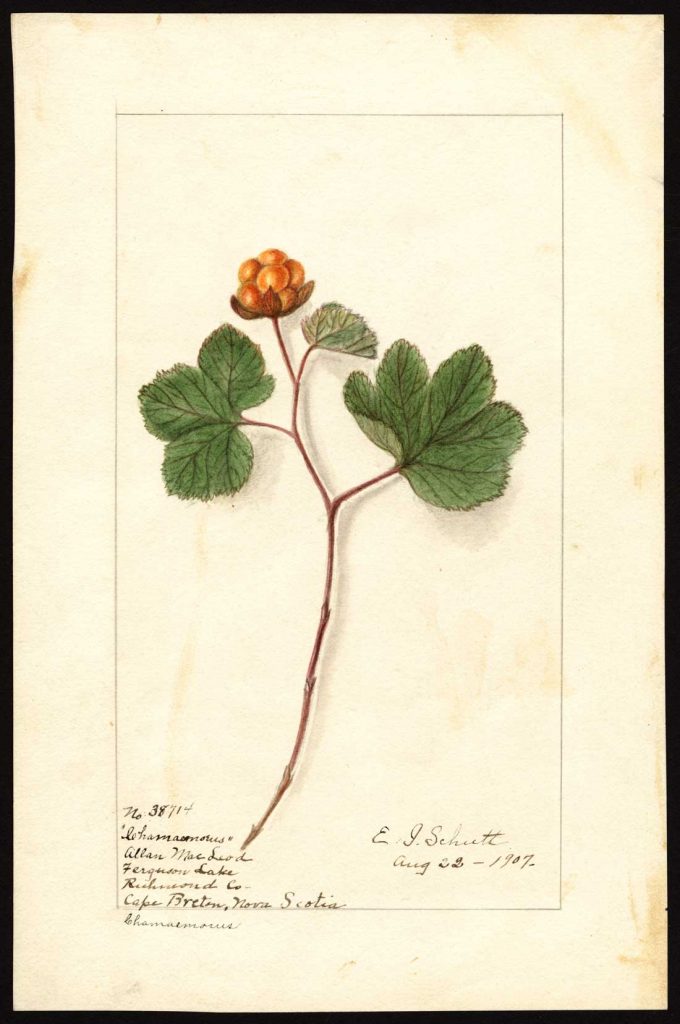
Anne Lister at Bolkesjø 4. Aug. 1839
Rubus chamaemorus is a species of flowering plant in the rose family Rosaceae, native to cool temperate regions, alpine and arctic tundra and boreal forest. This herbaceous perennial produces amber-colored edible fruit similar to the blackberry. English common names include cloudberry, nordic berry, bakeapple (in Newfoundland and Labrador), knotberry and knoutberry (in England), aqpik or low-bush salmonberry (in Alaska – not to be confused with salmonberry, Rubus spectabilis), and averin or evron (in Scotland).
Unlike most Rubus species, the cloudberry is dioecious, and fruit production by a female plant requires pollination from a male plant.
Cloudberries are a circumpolar boreal plant, occurring naturally throughout the Northern Hemisphere from 78°N, south to about 55°N, and are scattered south to 44°N mainly in mountainous areas and moorlands. In Europe, they grow in the Nordic countries, Baltic states and Poland. They occur across northern Russia east towards the Pacific Ocean as far south as Japan. Due to peatland drainage and peat exploitation, they are considered endangered and are under legal protection in Germany’s Weser and Elbe valleys, and at isolated sites in the English Pennines and Scottish Highlands. A single, fragile site exists in the Sperrin Mountains of Northern Ireland.
In North America, cloudberries grow wild across Greenland, most of northern Canada, Alaska, northern Minnesota, New Hampshire, Maine, and New York.
Cloudberry leaves are food for caterpillars of several Lepidoptera species. The moth Coleophora thulea has no other known food plants. See also List of Lepidoptera that feed on Rubus.
Despite great demand as a delicacy (particularly in Norway, Sweden and Finland) the cloudberry is not widely cultivated and is primarily a wild plant. Wholesale prices vary widely based on the size of the yearly harvest, but cloudberries have gone for as much as €10/kg (in 2004).
Since the middle of the 1990s, however, the species has formed part of a multinational research project. Beginning in 2002, selected cultivars have been available to farmers, notably ‘Apolto’ (male), ‘Fjellgull’ (female) and ‘Fjordgull’ (female). The cloudberry can be cultivated in Arctic areas where few other crops are possible, for example along the northern coast of Norway.
The ripe fruits are golden-yellow, soft and juicy, and are rich in vitamin C. When eaten fresh, cloudberries have a distinctive tart taste. When over-ripe, they have a creamy texture somewhat like yogurt and a sweetened flavor. They are often made into jams, juices, tarts, and liqueurs. In Norway, cloudberries (multer) are either served with cream and sugar or mixed with whipped cream and sugar to be served as a dessert called multekrem (cloudberry cream), as a jam or as an ingredient in homemade ice cream. Cloudberry yoghurt—molte- or multeyoughurt—is a supermarket item in Norway. In Finland, the berries are eaten with heated leipäjuusto (a local cheese; the name translates to “bread-cheese”), as well as cream and sugar. In Sweden, cloudberries (hjortron) and cloudberry jam are used as a topping for ice cream, pancakes, and waffles.
In Newfoundland and Labrador, Canada, cloudberries are used to make “bakeapple pie” or jam. Arctic Yup’ik mix the berries with seal oil, reindeer or caribou fat (which is diced and made fluffy with seal oil) and sugar to make akutaq. The recipes vary by region. The berries are an important traditional food resource for the Yup’ik.
Due to its high vitamin C content, the berry is valued both by Nordic seafarers and Northern indigenous peoples. Its polyphenol content, including flavonoid compounds such as ellagic acid, appears to naturally preserve food preparations of the berries. Cloudberries can be preserved in their own juice without added sugar, if stored cool.
Extract of cloudberries is also used in cosmetics such as shower gels, hand creams and body lotions.
In Nordic countries traditional liqueurs such as lakkalikööri (Finland) are made of cloudberry, having a strong taste and high sugar content. Cloudberry is used as a flavouring for making akvavit. In northeastern Quebec, a cloudberry liqueur known as chicoutai is made.
The cloudberry appears on the Finnish version of the 2 euro coin. The name of the hill Beinn nan Oighreag in Breadalbane in the Scottish Highlands means “Hill of the Cloudberries” in Scottish Gaelic.
Harvesting on public property
In some northern European countries such as Norway, a common use policy to non-wood forest products allows anyone to pick cloudberries on public property and eat them on location, but only local residents may transport them from that location and only ripe berries may be picked. Since 1970 in Norway, while it has been illegal to pick unripe cloudberries, transporting ripe cloudberries from the harvest location is permitted in many counties.